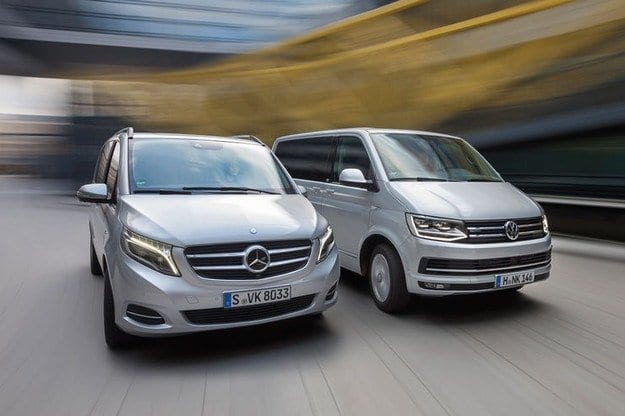
Test drive Mercedes V-Class against VW Multivan: volume celebration
Content

Two strong models in the large van segment look at each other
Let's put it this way: Big vans can provide a completely different and very enjoyable journey. Especially on powerful diesels and twin transmissions.
Traveling alone in such a car is blasphemous. You get behind the wheel and in the mirror you see an empty ballroom. And life is in full swing here ... In fact, these vans are made for exactly this - whether it be a large family, hotel guests, golfers and so on.
These Kingsize minivans with powerful diesel engines are ready for long and comfortable trips and - in our case - with dual transmission, they can be great helpers in mountain resorts. Passengers in them can expect plenty of room, and there's room when you need it (seven standard for VW, six for Mercedes).
Additional assistance systems in Mercedes
At 4,89 meters long, the Multivan is no longer than a mid-range car and, thanks to its good visibility, does not pose a parking problem. However, the V-Class – here in its medium version – provides even more space with its 5,14 meters. For a better view around the car, the driver can rely on a 360-degree camera system and Active Parking Assist. VW can not boast of this.
However, parking can sometimes be a problem because with side mirrors, both tubs are almost 2,3 meters wide. As we said, long-distance travel remains a priority for these cars. The dual transmission provides not only more off-road capability, but also greater cornering stability in these high-bodied models. To do this, both use a multi-plate clutch, and in the Multivan it is Haldex. The work of torque redirection systems remains invisible, but effective. Driving on slippery roads is made easier, especially with the VW, which also features a locking differential on the rear axle. At VW, to a lesser extent, the fact that the dual transmission still makes the car and steering difficult to some extent. However, this does not mean that the Mercedes model creates some difficulties - despite the weight of 2,5 tons and a high body.
The Mercedes leans less in corners and thanks to the comfortable seating position, while the lightweight steering wheel provides a car-like driving experience. Accurately describes the turning curve and then goes forward with pleasure. Even slightly more agile than its rival despite VW's higher horsepower, perhaps because the Mercedes' 2,1-liter engine develops 480 Nm at 1400 rpm and the 450-liter TDI Multivan reaches 2400 Nm at XNUMX rpm. rpm Only then does the Multivan show its muscles.
The seven-speed transmissions – automatic with torque converter and DSG with shut-off function – are ideally matched to high-torque engines, and each achieves harmony in its own way. Despite the mentioned freewheel mechanism, the VW in the test consumes 0,2 liters of fuel per 100 km more, but keeps the consumption value below 10 liters.
Luxury as a function of volume
If space is for you the epitome of luxury, then at Merceces you will truly feel luxurious. The second and third rows of seats provide the comfort of a sofa, but the Multivan does not deprive passengers of blissful comfort. The self-opening Mercedes rear window makes loading easier, and more luggage is revealed behind the door. However, when rearranging the interior, VW takes the lead because the "furniture" slides more easily on the rails. In practice, both machines offer a lot in terms of functionality and flexibility. Options include a variety of seating configurations and a host of other amenities, such as cooled Mercedes rear seats and VW built-in child seats.
The V-Class rides with one idea more comfortably and, above all, absorbs small bumps better. Noise reduction is better than the Multivan, both measured and subjective. However, the differences are not significant - both machines provide a pleasant atmosphere even when driving at a speed of 200 km / h. The brakes also do an excellent job, given the weight, which reaches three tons at full load, but even then they do not look overloaded.
However, the buyer's budget seems to be overloaded, because both cars are not cheap at all. Almost everything - the navigation system, leather upholstery, side airbags - is paid extra. However, you will not find LED lights for an additional fee in VW, and in terms of assistance systems, Mercedes has advantages. Thanks to all of the above, Mercedes is in the lead. Although the Multivan is relatively expensive, it also offers a lot and actually only loses one iota to its rival.
Text: Michael Harnishfeger
Photo: Ahim Hartmann
Evaluation
1. Mercedes - 403 points
The V-Class offers more space for people and luggage, as well as more driver assistance systems, drives more comfortably and becomes more profitable with more equipment.
2. Volkswagen – 391 points
The Multivan falls far behind in terms of safety and support equipment. Here you can see that the T6 is not a completely new model. It's a little faster - and a lot more expensive.
technical details
| 1. Mercedes | 2. Volkswagen | |
|---|---|---|
| Working volume | 2143 cc cm | 1968 cc cm |
| Power | 190 k.s. at 3800 rpm | 204 k.s. at 4000 rpm |
| Maximum torque | 480 Nm at 1400 rpm | 450 Nm at 2400 rpm |
| Acceleration 0-100 km / h | 11,2 with | 10,6 with |
| Braking distances at a speed of 100 km / h | 37,5 m | 36,5 m |
| full speed | 199 km / h | 199 km / h |
| Average consumption fuel in the test | 9,6 l / 100 km | 9,8 l / 100 km |
| Base Price | 111 707 levov | 96 025 levov |

